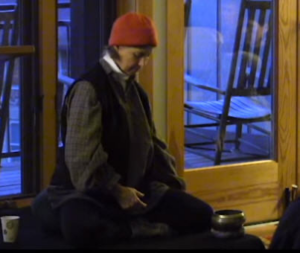
Centering Prayer is a Christian contemplative form of meditation practice developed in the 1970s by three Trappist monks, Fathers William Meninger, Basil Pennington and Thomas Keating. The practice method draws upon the contemplative heritage found within biblical scripture and Christian mystical writings such as the medieval classic The Cloud of Unknowing. Centering Prayer is a growing form meditation used both for regular individual practice, as well as in group settings.
Where Centering Prayer is distinct and differs from most other mediation approaches is instead of relying on the power of focused attention (such as concentrating on the flow of one’s breath or repeating a mantra) the energy of one’s intention becomes the primary source for engaging the practice. In broad terms, that intention can be described as being totally open and available to God, all the way down the innermost point of your being and deeper than your usual sense of self. Through aligning with that intention, the simple method of Centering Prayer consists of learning to withdraw attention from our limitless stream of thoughts. As we practice this inner releasing, we provide the opportunity to rest in a gentle, open attentiveness to divine reality itself.
What grows as practitioners develop a regular practice of Centering Prayer is a greater “attention of the heart” and a subtle “objectless awareness” that unlocks and broadens a more unitive field of perceptivity.*
There are numerous books and resources listed at the end of this page to provide detailed instruction and deepening approaches to Centering Prayer. Here is a brief overview of how the method is practiced:
- It is preferable to find a quiet place to sit comfortably where you will be undisturbed for the period of time you are setting aside for your centering prayer. That said, you can still proceed with your practice even if the environment and conditions are not ideal.
- There are a variety of meditation benches, cushions and sitting accessories widely available, but sitting upright in a standard chair is perfectly fine.
- The prescribed daily practice is a minimum of two 20-minute sits. If at all possible this amount is most recommended to start and maintain a dedicated practice. A timer or nearby clock is helpful to time the sitting period.
- An aid to help in returning to the essence of the practice is to select and use a sacred word or short phrase that can act as a placeholder or symbol for your intention.
- Aiming to stay relaxed but attentive, close your eyes, and start your practice period rooting in your basic intention of open availability to God.
- Each time you notice yourself becoming absorbed in a thought, and without making a problem of your distraction, gently release your attention from the thought and inwardly say your sacred word. Your sacred word is not constantly repeated like a mantra, but only used as much as required to bring yourself back into alignment with your original intention.
- In the context of this practice, a thought is defined as anything that brings your attention to a focal point. This could be an idea, vision, memory, emotion, or dwelling upon a physical sensation. If it captures your attention, it’s considered a thought, and by letting go you are renewing your intention and consent for “God’s presence and action within.”
- As you continue in the prayer period and thoughts inevitably arise, use your sacred word to gently and quickly clear your mental debris, and to return to open awareness and availability.
- When the alloted time is up, slowly open your eyes. Without rushing, take a few minutes to allow yourself to come back to your usual state of consciousness.
- If planning longer periods of sitting, many find a very slow meditative walk after each 20 minutes or so helps to keep the body more comfortable and alert.
“… your aim is to be deeply available to God—that is, available at the depths of your being, deeper than words, memories, emotions, sensations; deeper even than your felt sense of “I am here.” You are simply asked to attend, to give yourself, completely to that deeper, mysterious presence.” ~ Cynthia Bourgeault, Centering Prayer and Inner Awakening

Teachings by Cynthia Bourgeault on Centering Prayer
Books:
- The Heart of Centering Prayer: Nondual Christianity in Theory and Practice
- Centering Prayer and Inner Awakening
Instructional Audios for Purchase:
Online Study:
Web resources:
- The Heart of Centering Prayer with Cynthia Bourgeault (4-part video teaching)
- Centering Prayer and the Foundations of Non-Dual Awareness, presentation at 2012 Science and Nonduality Conference
- Cynthia speaks about Centering Prayer with Shambhala Editor
This resource was contributed by Wisdom Way of Knowing


